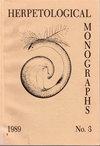牙买加和大开曼群岛Grahami系列变色龙的摆动显示分析
IF 1
2区 生物学
Q3 ZOOLOGY
引用次数: 1
摘要
摘要:行为生物学家长期以来一直对求偶和同性竞争中产生的动物信号的多样性着迷。在这种情况下,许多蜥蜴都会进行引人注目的摆动表演,许多研究都致力于描述这些表演。传统上,浮动显示器被划分为多个单元,这些单元的持续时间(有时还有头部振幅)被测量。最近,马其顿等人(2019)引入了离散傅立叶变换(DFT)作为基于单位的变量的替代方法,用于表征加拉帕戈斯熔岩蜥蜴(Microlophus spp.)展示结构中的物种特异性特征。然而,由于物种间展示单位的同源性不确定,因此没有直接比较这两种方法的相对成功。在这里,我们使用Anolis蜥蜴的“grahami系列”克服了这个问题——这是牙买加和大开曼群岛上七个物种的单系辐射。我们的研究有三个主要目标。我们的第一个目标是发现基于DFT的测量、基于单元的测量或它们的组合是否提供了捕捉显示结构中特定分类单元的独特性的最佳手段。为此,我们量化了波动显示,并使用嵌套方差分析(ANOVA)来确定特定变量在区分一个物种内的种群方面是否可靠。然后,我们使用主成分分析来减少测量变量的数量,并将这些成分输入判别函数分析中,以确定哪种方法在分类群中最有区别。结果表明,没有一种类型的测量或测量组合能够在比较中始终更好地区分分类群。我们的第二个目标是检验我们在加拉帕戈斯熔岩蜥蜴中的发现所产生的一个假设,即随着浮动显示结构复杂性的增加,DFT的有效性可能会降低。在这个测试中,我们使用了四种来自Anolis reconcitus物种的简单和复合展示类型。判别函数分析的结果为该假设提供了混合支持,我们建议DFT性能和显示复杂性的最终测试应该使用显示结构属性系统变化的合成显示。最后,我们展示了浮动显示结构如何映射到grahami系列anoles的基于DNA的系统发育中。尽管一些物种在这种适应性辐射中产生了更多基础物种的展示所没有预料到的衍生展示类型,但其他物种则表现出了将它们与分支中某个物种的特定种群联系起来的特征。本文章由计算机程序翻译,如有差异,请以英文原文为准。
Analysis of Bobbing Displays in the Grahami Series Anoles from Jamaica and Grand Cayman
Abstract: Behavioral biologists have long been fascinated with the diversity of animal signals produced in the contexts of courtship and same-sex competition. In these contexts many lizards engage in conspicuous bobbing displays, and numerous studies have been devoted to describing these displays. Traditionally, bobbing displays are partitioned into units whose durations (and sometimes head amplitudes) are measured. Recently, Macedonia et al. (2019) introduced use of the Discrete Fourier Transform (DFT) as an alternative to unit-based variables for characterizing species-specific traits in display structure of Galápagos Lava Lizards (Microlophus spp.). The relative success of the two methods was not compared directly, however, because the homology of display units among species was uncertain. Here we overcome this problem using the “grahami series” of Anolis lizards—a monophyletic radiation of seven species on Jamaica and Grand Cayman. Our study had three primary goals. Our first goal was to discover whether DFT-based measures, unit-based measures, or their combination provided the best means to capture taxon-specific distinctiveness in display structure. To this end, we quantified bobbing displays and used nested analyses of variance (ANOVAs) to determine if particular variables were reliably superior at differentiating populations within a species. We then used principal components analysis to reduce the number of measurement variables, and entered the components into discriminant function analyses to determine which approach best discriminated among taxa. Results showed that no one type of measurement, or measurement combination, emerged as being consistently better at discriminating taxa across comparisons. Our second goal was to test a hypothesis that arose from our findings in Galápagos Lava Lizards—that the DFT may decrease in effectiveness as bobbing display structure increases in complexity. For this test we used four simple and compound display types from the species Anolis reconditus. Results of discriminant function analyses provided mixed support for the hypothesis, and we suggest that a definitive test of DFT performance and display complexity should utilize synthetic displays in which attributes of display structure are varied systematically. Last, we show how bobbing display structure maps onto alternative DNA-based phylogenies of the grahami series anoles. Whereas some species produced derived display types unanticipated from displays of more basal species in this adaptive radiation, others exhibited features that linked them to a particular population of a species in their clade.
求助全文
通过发布文献求助,成功后即可免费获取论文全文。
去求助
来源期刊

Herpetological Monographs
生物-动物学
CiteScore
5.40
自引率
0.00%
发文量
2
审稿时长
>12 weeks
期刊介绍:
Since 1982, Herpetological Monographs has been dedicated to original research about the biology, diversity, systematics and evolution of amphibians and reptiles. Herpetological Monographs is published annually as a supplement to Herpetologica and contains long research papers, manuscripts and special symposia that synthesize the latest scientific discoveries.
 求助内容:
求助内容: 应助结果提醒方式:
应助结果提醒方式:


